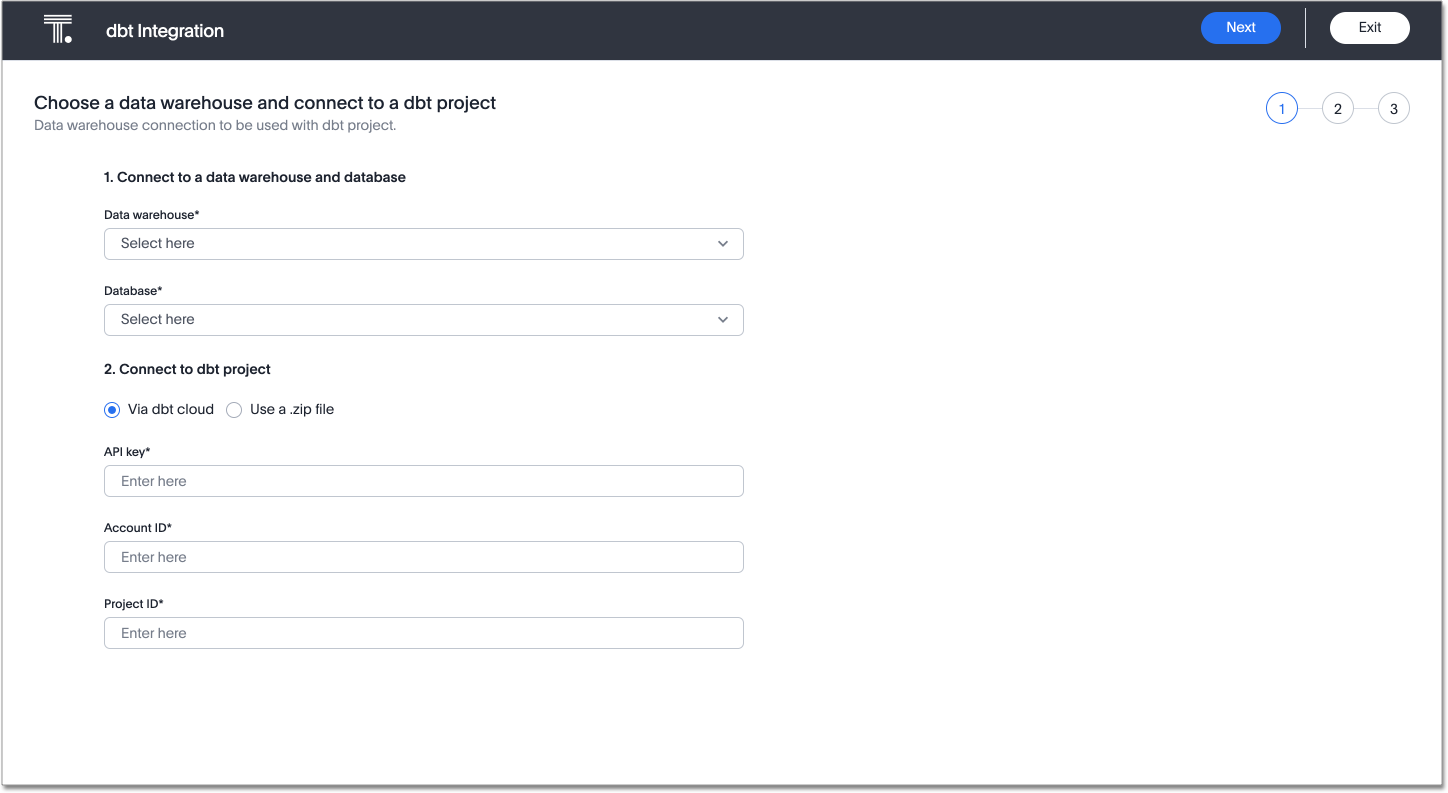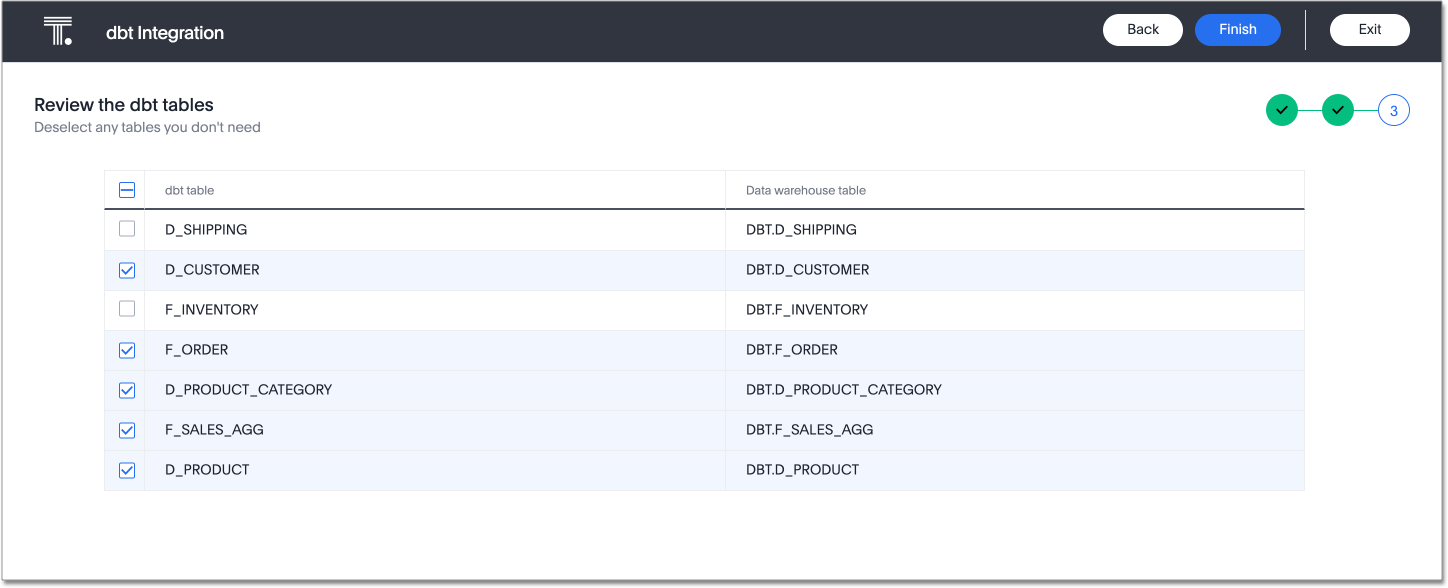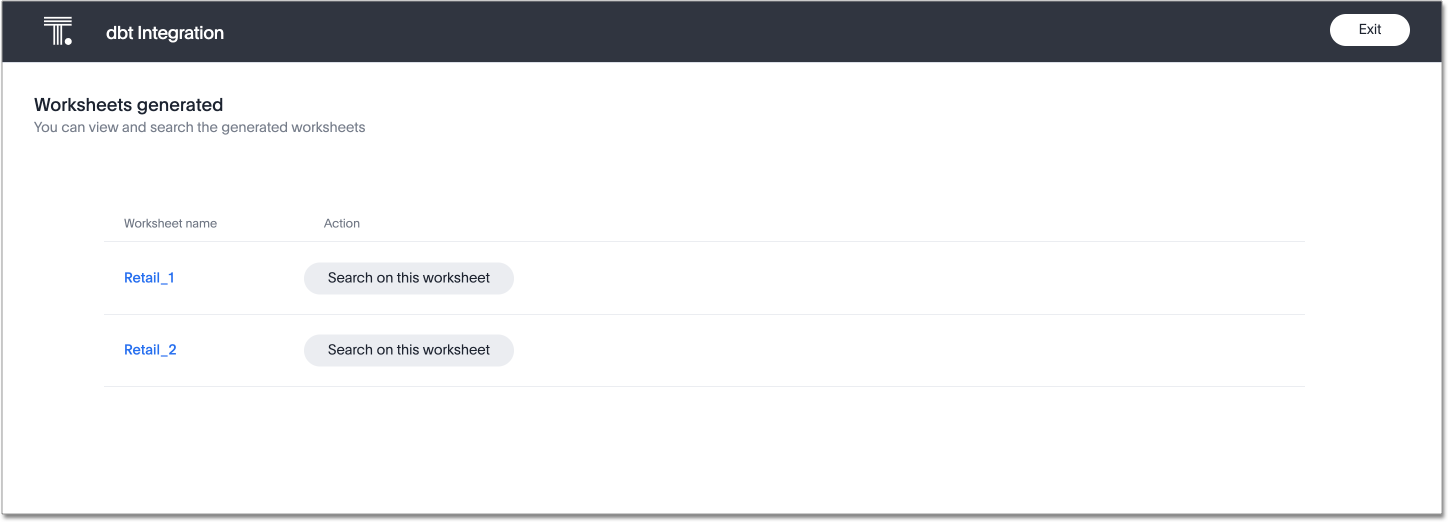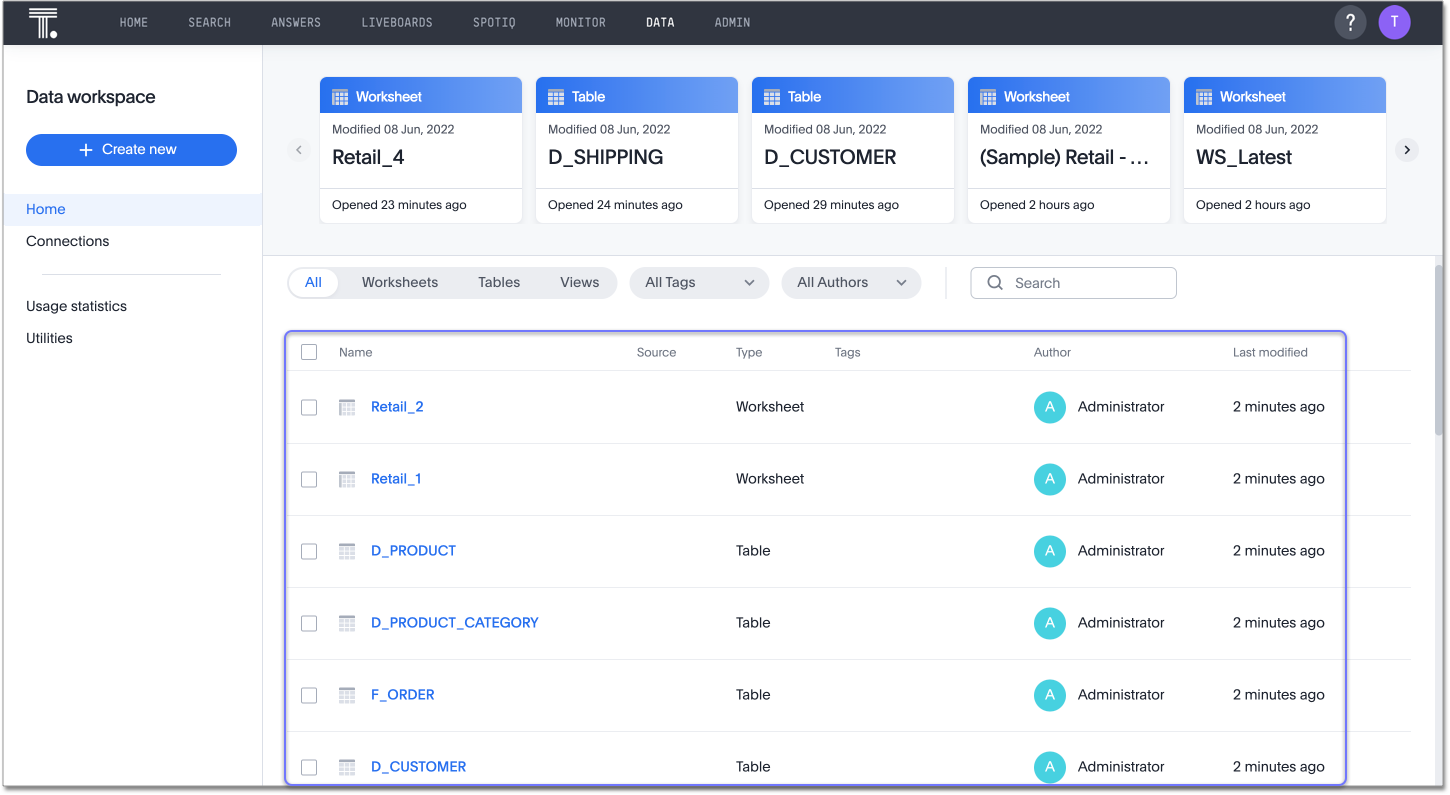Integrate with dbt
ThoughtSpot’s dbt integration allows you to easily provide your existing dbt models and automatically create ThoughtSpot Worksheets, which you can use to search your data.
dbt takes your raw data in your data warehouse and transforms and validates it. ThoughtSpot’s dbt integration connects users to their cloud data warehouse, integrates with your dbt models using an API key or zip file, and generates the relationships between the tables defined in the dbt model that you select. Then, ThoughtSpot creates new Worksheets, based on the relationships between the tables. These Worksheets provide user-friendly logical views of your complex datasets. Users can use these Worksheets to easily search their complex data. This process may replace existing dbt tables you imported into ThoughtSpot, but it will not replace existing Worksheets.
| Integration with dbt is certified only for Snowflake connections. |
Prerequisites
Before you can integrate with dbt, you must satisfy the following prerequisites
-
Create a connection to your external cloud data warehouse. This cloud data warehouse must contain the tables that are created from your dbt models.
-
If you connect to dbt via dbt cloud, you need the API key, Account ID, and Project ID:
- API key
-
This is also called the API token in dbt. To find this token, refer to the dbt documentation.
- Account ID
-
Your default dbt Cloud account ID. Find your account ID in your dbt Cloud URL, after you log in. For example, if your URL is
https://cloud.getdbt.com/#/accounts/12345/projects/56789/dashboard, your account ID is12345. - Project ID
-
Find your project ID in your dbt Cloud URL, after you log in. For example, if your URL is
https://cloud.getdbt.com/#/accounts/12345/projects/56789/dashboard, your project ID is56789.
-
Optionally define the relationships for the dbt models in your
ymlschema file. For more information, refer to the dbt documentation.If you do not define relationships, ThoughtSpot imports each model as a single table and creates one Worksheet based on each table. -
To ensure ThoughtSpot can process the latest changes defined in your
ymlschema file, which defines relationships, metatags, and tests, you must have the latest versions of themanifest.jsonandcatalog.jsonfiles. To ensure you have the latest versions of those files, run a dbt job, which generates the latest versions of these files. -
If you are using dbt cloud, the generate docs on run setting must be on. You can enable this setting in the jobs settings of the project, under Execution settings.
-
If you are using dbt core, execute the
dbt docs generatecommand along with thedbt runcommand. -
If you are using dbt core, you must connect to dbt using a zip file, which must contain the latest
manifest.jsonandcatalog.jsonfiles. By default, dbt stores these files under the<project name>/targetfolder.When you compress the manifest.jsonandcatalog.jsonfiles into one zip file, ensure that you do not include any hidden files, as this may cause errors later. To check the folder you plan to compress does not contain hidden files, refer to these articles for viewing hidden files on your Mac or Windows computer. If the folder contains hidden files, move them out of the folder before compressing it into a zip file.
How the dbt integration works
To integrate with dbt, ThoughtSpot reads information from the latest versions of the manifest.json and catalog.json files. In the prerequisites, you ensured that ThoughtSpot could find these files, either by enabling the generate docs on run setting in dbt cloud, or by creating a zip file with your manifest.json and catalog.json files for dbt core.
ThoughtSpot reads the following information from the manifest.json file. Make sure that the manifest.json file contains the latest details of your yml schema file.
-
Database name
-
Schema name
-
Model/Table name
-
Table description
-
Column name
-
Column description
-
Table relationships (joins)
ThoughtSpot reads the following information from the catalog.json file:
-
Column data types
How ThoughtSpot creates Worksheets from dbt
ThoughtSpot creates Worksheets based on the table relationships defined in a schema.yml file in the models directory.
The Worksheet creation follows these steps:
-
ThoughtSpot creates logical tables based on the model files. In the following example, ThoughtSpot creates a table for d_customer, d_product, d_product_category, and so on.
-
ThoughtSpot creates joins between the logical tables, based on the relationships defined in the
schema.ymlfile. In the following example, ThoughtSpot creates joins between d_product and d_product_category, d_shipping and d_customer, and so on. -
ThoughtSpot creates Worksheets made up of the logical tables, based on the relationships defined in the
schema.ymlfile.
For example, based on the following schema.yml file, ThoughtSpot creates the following Worksheets:
Download the schema.yml file here.
Click to view the yml schema file
models:
- name: d_customer
description: "Customer Dimension"
columns:
- name: customer_id
description: "customer id"
- name: first_name
description: "First Name"
- name: last_name
description: "Last Name"
- name: email
description: "Email address"
- name: gender
description: "Gender - F/M"
- name: dob
description: "Date of birth"
- name: d_product
description: ""
columns:
- name: product_id
description: ""
- name: product_category_id
description: ""
tests:
- not_null
- relationships:
to: ref('d_product_category')
field: product_category_id
- name: product_name
description: ""
- name: price
description: ""
- name: d_shipping
description: ""
columns:
- name: shipping_id
description: ""
- name: customer_id
description: ""
tests:
- not_null
- relationships:
to: ref('d_customer')
field: customer_id
- name: street
description: ""
- name: city
description: ""
- name: state
description: ""
- name: zipcode
description: ""
- name: d_product_category
description: ""
columns:
- name: product_category_id
description: ""
- name: product_category_name
description: ""
- name: f_inventory
description: ""
columns:
- name: product_id
description: ""
tests:
- not_null
- relationships:
to: ref('d_product')
field: product_id
- name: product_category_id
description: ""
tests:
- not_null
- relationships:
to: ref('d_product_category')
field: product_category_id
- name: quantity
description: ""
- name: last_shipped_quantity
description: ""
- name: last_order_date
description: ""
- name: as_of_date
description: ""
- name: f_order
description: ""
columns:
- name: order_id
description: ""
- name: customer_id
description: ""
tests:
- not_null
- relationships:
to: ref('d_customer')
field: customer_id
- name: shipping_id
description: ""
tests:
- not_null
- relationships:
to: ref('d_shipping')
field: shipping_id
- name: product_id
description: ""
tests:
- not_null
- relationships:
to: ref('d_product')
field: product_id
- name: product_category_id
description: ""
tests:
- not_null
- relationships:
to: ref('d_product_category')
field: product_category_id
- name: units
description: ""
- name: price
description: ""
- name: order_date
description: ""
metrics:
- name: new_customers
label: New Customers
model: ref('d_customer')
description: "The number of paid customers using the product"
type: count
sql: user_id # superfluous here, but shown as an example
timestamp: signup_date
time_grains: [day, week, month]
dimensions:
- plan
- country
filters:
- field: is_paying
operator: 'is'
value: 'true'
- field: lifetime_value
operator: '>='
value: '100'
- field: company_name
operator: '!='
value: "'Acme, Inc'"
- field: signup_date
operator: '>='
value: "'2020-01-01'"| Model name | Relationship to | Worksheet created? |
|---|---|---|
d_customer |
none |
No. This model file only has relationships from other model files. It does not have relationships to other model files. |
d_product |
d_product_category |
Yes. The Worksheet consists of the 2 tables: d_product and d_product_category. |
d_shipping |
d_customer |
Yes. The Worksheet consists of the 2 tables: d_shipping and d_customer. |
d_product_category |
none |
No. This model file only has relationships from other model files. It does not have relationships to other model files. |
f_inventory |
d_product, d_product_category |
Yes. The Worksheet consists of the 3 tables: f_inventory, d_product, and d_product_category. |
f_order |
d_customer, d_shipping, d_product, d_product_category |
Yes. The Worksheet consists of the 5 tables: f_order, d_customer, d_shipping, d_product, and d_product_category. |
Integrating with dbt
You can set up your dbt integration from the Data workspace. To integrate with dbt, follow these steps:
-
Ensure that you have already created a connection to your external cloud data warehouse. This cloud data warehouse must contain the tables that are created from your dbt models.
-
Select Data in the top navigation bar.
-
Select Utilities in the side navigation bar.
-
Under dbt Integration, select Open dbt integration wizard. The dbt integration wizard opens.

-
Under Data warehouse, select the cloud data warehouse you would like to use from the dropdown, or search for it using the search bar in the dropdown.
-
Under Database, select the database within the cloud data warehouse that you would like to use from the dropdown, or search for it using the search bar in the dropdown. This database must contain the tables that are created from your dbt models.
-
Under Connect to dbt project, select either Via dbt cloud or Use a .zip file. If you are using dbt core, you must select Use a .zip file.
-
If you select Via dbt cloud, fill in the following parameters:
- API key
-
This is also called the API token in dbt. To find this token, navigate to your Account Settings page in dbt cloud. Click on the Service Account tokens page, and generate a new token.
- Account ID
-
Your default dbt Cloud account ID. Find your account ID in your dbt Cloud URL, after you log in. For example, if your URL is
https://cloud.getdbt.com/#/accounts/12345/projects/56789/dashboard, your account ID is12345. - Project ID
-
Find your project ID in your dbt Cloud URL, after you log in. For example, if your URL is
https://cloud.getdbt.com/#/accounts/12345/projects/56789/dashboard, your project ID is56789.
-
If you select Use a .zip file, click the Upload button, and add the zip file from your files. The zip file must contain the latest
manifest.jsonandcatalog.jsonfiles. By default, dbt stores these files under the<project name>/targetfolder.When you compress the manifest.jsonandcatalog.jsonfiles into one zip file, ensure that you do not include any hidden files, as this may cause errors later. To check the folder you plan to compress does not contain hidden files, refer to these articles for viewing hidden files on your Mac or Windows computer. If the folder contains hidden files, move them out of the folder before compressing it into a zip file. -
Select Next.
-
On the next screen, select a dbt folder to import. ThoughtSpot lists the model names, paths, and the number of tables they have. Your model must have at least 2 tables. You must select at least 2 tables within the dbt folder. These tables must have relationships to each other.

-
Select Next.
-
If you receive the following error, make sure you executed the dbt project with the
GENERATE DOCSoptionON, and verify that you entered the API key, account ID, and project ID correctly. If you are using dbt cloud, ensure that thegenerate docs on runsetting is on. You can enable this setting in the jobs settings of the project, under Execution settings. If you are using dbt core, execute thedbt docs generatecommand along with thedbt runcommand. After verifying everything, run the dbt connection again.Unable to connect to dbt project. Please verify API key and retry

-
On the next screen, select tables to import. By default, ThoughtSpot imports all tables in the folder. Deselect any tables you do not want to import.

-
Select Finish.
-
The Worksheets generated page appears. ThoughtSpot generates several Worksheets from your dbt models.

To inspect the Worksheet details, click on any of the Worksheet names.
To search the data on the Worksheet, select Search on this worksheet next to any Worksheet.
-
Select Exit.
-
On the Data workspace home page, you can see the tables and Worksheets that you just created from dbt.

This process may replace existing dbt tables you imported into ThoughtSpot, but it will not replace existing Worksheets. -
If you click on any of the tables and Worksheets you created, and then select Joins, you can see the joins ThoughtSpot created, based on the relationships in dbt.
-
If there are any changes to the dbt models that you would like the ThoughtSpot Worksheets and tables to reflect, you must run the dbt integration again, which creates a new set of Worksheets, and updates the existing tables.
Limitations
-
Currently, you can only connect to one dbt folder at a time.
-
The integration does not currently support relationships defined across folders.
-
You must select at least 2 tables within the dbt folder. These tables must have relationships to each other.
-
If you make changes to your dbt models in dbt, ThoughtSpot does not automatically reflect those changes. You must integrate with dbt again. This may affect changes you made to the tables and Worksheets in ThoughtSpot.
Troubleshooting
For help troubleshooting issues with your dbt integration, see Common errors encountered during dbt integration.



